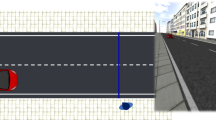Abstract
It is known that audiovisual warnings that have a higher urgency can achieve a faster driver’s response, i.e., shorter response times of braking and a secondary task during driving. However, the steering response has not been examined in earlier works. Moreover, few studies have examined the effects of the urgency of audiovisual warnings on the accuracy of a response regardless of whether braking or performing a secondary task. In this study, experiments using a driving simulator is carried out to investigate the effects of the urgency of audiovisual collision warnings on the response time and accuracy of steering in a case where a driver avoids a crash by performing a lane change.






Similar content being viewed by others
Explore related subjects
Discover the latest articles and news from researchers in related subjects, suggested using machine learning.References
Meng, F., Spence, C.: Tactile warning signals for in-vehicle systems. Accid. Anal. Prev. 75, 333–346 (2015)
Lorenz, L., Kerschbaum, P., Schumann, J.: Designing take over scenarios for automated driving: how does augmented reality support the driver to get back into the loop?, Proceedings of the Human Factors and Ergonomics Society 58th Annual Meeting, pp. 1681–1685 (2014)
Scott, J.J., Gray, R.: A comparison of tactile, visual, and auditory warnings for rear-end collision prevention in simulated driving. Hum. Factors. 50(2), 264–275 (2008)
Zhang, Y., Antonsson, E. K., Grote, K., A new threat assessment measure for collision avoidance systems, Proceeding of the IEEE ITSC, pp. 968–975 (2006)
Levy, J., Pashler, H.: Task prioritisation in multitasking during driving: opportunity to abort a concurrent task does not insulate braking responses from dual-task slowing. Appl. Cogn. Psychol. 22(4), 507–525 (2008)
Politis, I., Brewster, S., Pollick, F.: Evaluating multimodal driver displays of varying urgency. Proceedings of AutomotiveUI ‘13. 92–99 (2013)
Politis, I., Brewster, S., Pollick, F.: Evaluating multimodal driver displays under varying situational urgency. Proceedings of CHI ‘14. 4067–4076 (2014)
Marshall, D.C., Lee, J.D., Austria, P.A.: Alerts for in-vehicle information systems: annoyance, urgency, and appropriateness. Hum. Factors. 49(1), 145–157 (2007)
Baldwin, C.L., Lewis, B.A.: Perceived urgency mapping across modalities within a driving context. Appl. Ergon. 45(5), 1270–1277 (2014)
Baldwin, C.L.: Multimodal urgency coding: auditory, visual, and tactile parameters and their impact on perceived urgency. Work. 41, 3586–3591 (2012)
Baldwin, C.L.: Verbal collision avoidance messages during simulated driving: perceived urgency, alerting effectiveness and annoyance. Ergonomics. 54(4), 328–337 (2011)
Baldwin, C.L., May, J.F.: Loudness interacts with semantics in auditory warnings to impact rear-end collisions. Transp. Res. F. 14(1), 36–42 (2011)
Hofmann, P., Rinkenauer, G., Gude, D.: Preparing lane changes while driving in a fixed-base simulator: effects of advance information about direction and amplitude on reaction time. Transp. Res. F. 13(4), 255–268 (2010)
Hofmann, P., Rinkenauer, G.: Response preparation in a lane change task. Ergonomics. 56(2), 268–281 (2013)
Winsum, W., Brookhuis, K.A., de Waard, D.: A comparison of different ways to approximate time-to-line crossing (TLC) during car driving. Accid. Anal. Prev. 32(1), 47–56 (2000)
Cario, G., Casavola, A., Franzè, G., Lupia, M., Brasili, G.: Predictive time-to-lane-crossing estimation for lane departure warning systems. Proceedings of the 21st International Technical Conference on the Enhanced Safety of Vehicles. 09–0312 (2009)
Sjӧberg, H.: Relations between heart rate, reaction speed, and subjective effort at different work loads on a bicycle ergometer. J. Hum. Stress. 1(4), 21–27 (1975)
Welford, A.T.: Chapter 9. In: Reaction Times. Academic Press, London (1980)
Arent, S.M., Landers, D.M.: Arousal, anxiety, and performance: a reexamination of the inverted-U hypothesis. Res. Q. Exerc. Sport. 74(4), 436–444 (2003)
Hellier, E., Edworthy, J., Weedon, B., Walters, K., Adams, A.: The perceived urgency of speech warnings: semantics versus acoustics. Hum. Factors. 44(1), 1–17 (2002)
Fagerlӧnn, J., Distracting effects of auditory warnings on experienced drivers, The 16th International Conference on Auditory Display, ICAD-127 (2010)
Jacobs, K.W., Hustmyer, J.R., E, F.: Effects of four psychological primary colors on GSR, heart rate and respiration rate. Percept. Mot. Skills. 38, 763–766 (1974)
Sternberg, R.J.: Chapter 10. In: The Nature of Cognition. MIT Press, Cambridge (1999)
Haith, A.M., Pakpoor, J., Krakauer, J.W.: Independent of movement preparation and movement initiation. J. Neurosci. 36(10), 3007–3015 (2016)
Author information
Authors and Affiliations
Corresponding author
Additional information
Publisher’s Note
Springer Nature remains neutral with regard to jurisdictional claims in published maps and institutional affiliations.
Rights and permissions
About this article
Cite this article
Kaizuka, T., Nakano, K. Effects of Urgency of Audiovisual Collision Warnings on Response Time and Accuracy of Steering. Int. J. ITS Res. 18, 90–97 (2020). https://doi.org/10.1007/s13177-018-0174-6
Received:
Revised:
Accepted:
Published:
Issue Date:
DOI: https://doi.org/10.1007/s13177-018-0174-6




